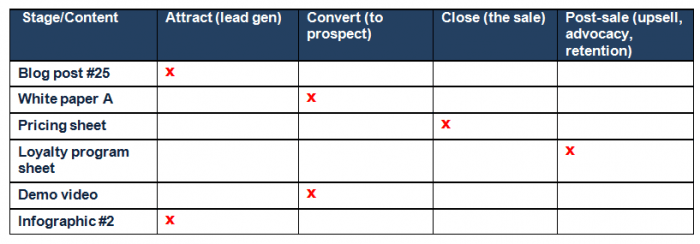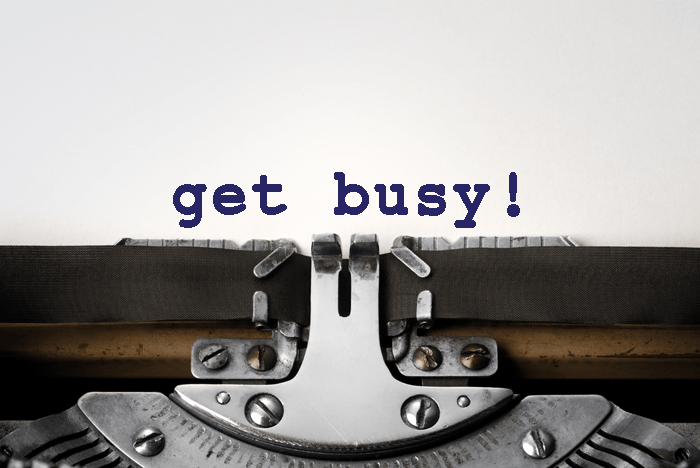Not long ago I had a great conversation with a marketer whose company had recently adopted Act-On. He said nice things about our content (always music to our ears) and asked the $64,000 question:
 Any tips on developing our own content marketing library?
Any tips on developing our own content marketing library?
I like hearing this question, because I love answering it. Here are three tips on creating a content library that will meet the needs of your customers and prospects – and position your company as the source for thought leadership in your industry.
1. Assess your existing content
Begin by understanding your own customer base, and the content that they find useful and valuable at the progressives stages of the buyer’s journey. Talk to your sales team, and find out what conversations and questions they’re asked that move the needle. Then:
- Formalize the stages of that buyer’s journey. If it doesn’t map to what you currently think of as stages in the sales funnel, you may want to reorient that sales funnel around the way the buyer actually purchases. Again, do this in tandem with your sales team.
- Once sales and marketing are in agreement about the buyer’s journey, create a chart. Give each stage of the journey a column on the horizontal axis of the chart.
- You could add columns for different products if that makes sense for your business.
- Assign all your content to one (and only one) stage. Assign it to as many product categories as necessary.
Your grid might look something like this:
 You can also use a content management system to visualize your content. Whatever you choose, your goal is for sales and marketing to understand the usability of what you already have, and to perceive the gaps.
You can also use a content management system to visualize your content. Whatever you choose, your goal is for sales and marketing to understand the usability of what you already have, and to perceive the gaps.
2. Decide what content to create.
Every team in your company needs content. The demand generation team is working to attract new customers, and is creating campaigns for buyers at every stage of the journey. The sales team needs bottom-funnel pieces like pricing sheets and product specs. Your customer support team may have their own needs. Visualizing your content will help you balance out each team’s needs and timing.
As a company begins to build out a library of content, the emphasis is usually placed on lead generation and the first three-quarters of the buyer’s journey. This is because these days, buyers don’t engage (or, often, even identify themselves) until fairly late in the buying cycle. Your content has to do all the heavy lifting in the early stages, including attracting the unknown prospects and converting them to prospects, so this is where you need it most.
No matter where you decide to start – top of funnel or post purchase – remember you’re actually creating that content for the customers and prospects who will consume it. Keep your reader persona in mind as you create or outsource your content.
3. Create that content.
Now you’ve analyzed what you have and what you need, the teams are in agreement, and you’re ready to make content happen. Buy or build? If you have the talent and time in-house, building your own is the best bet. It’s easier for your own creators to stay on message and within branding guidelines, and there’s more accountability. You also develop an in-house sensibility around search engine optimization that gets organically shared across your content.
(Gratuitous plug warning) If you decide to “buy” – please consider one of the very talented marketing agencies that partner with Act-On Software. You can research them here.
 Here are four ways to get the biggest bang for your time and money:
Here are four ways to get the biggest bang for your time and money:
- Use the “Rule of 4.” Try to create content that can be broken down into at least four pieces when possible. That white paper should also be a blog post or two, plus a data sheet… and can be the foundation for a webinar. Or your notes for a webinar can be revised into a paper, which is abstracted for a blog post, which becomes an infographic.
- Interview people inside your company about your customer challenges. You’ll be surprised at how much content you can write just through these conversations. Bring a digital recorder everywhere. These can be converted into podcasts with relatively little effort and editing … which in turn can be transcribed into papers and blog posts.
- Fast facts. Compile research about your industry into a paper, or have it available as snippets to pepper these into your other content pieces. Use proper citations. This helps bolster your credibility as an industry expert. Revisit this regularly to keep it current; outdated facts can be worse than no facts.
- Customer quotes and testimonials. Nothing is more credible than an independent endorsement. Find your evangelists and take them to dinner/lunch/drinks. They want to tell their story. You get to write it and make them heroes.
Caveats:
- Set expectations you can fulfill. It’s easy to plan a full slate of content projects; it’s much harder to create them all. A well-written blog post can take four to six hours; a well-written two-page four to six days, and a well-written eBook four to six weeks. Don’t set yourself up to fail (that demoralizes the team) with too many projects or too-short deadlines.
- Don’t be afraid to outsource when you need to. (Again, the Act-On partner roster is a great place to look for agencies that understand how to create marketing content.)
- Pay attention to your competitors’ content, so you know what your potential buyers are being exposed to. Do it a little differently…or do it a little better. Be edgier, if that suits your company’s personality.
- Don’t let the Great be the enemy of the Good. You want everything to be an A+, but sometimes you might have to take a B+ to get something out the door on time. As you continue to create content and see the traction it gets (or doesn’t) you’ll get a sense of what it takes for a piece to perform well. Plus – it takes a heckuva lot of time to get from 80% to 95%, and even more to get from 95% to 100%.
- Speaking of traction: Keep track of what gets downloaded and what contributes to conversion at the various points in the funnel. You may find that the short, practical pieces produce more than the long white papers at a certain point, or (more likely) that you really need a certain kind of mix. Whatever that truth may be for your unique set of future customers, you need to know it, so you can act on it.
Inspiration by walking around
Make sure your content creators are interacting with others inside and outside the company. The best performing content piece I ever created was a “3 Myths” white paper. It came from a 10 -minute conversation I had with a COO who was complaining about some pesky customers (this was in one of my former lives). I put those frustrations on paper, showed how our company solved the problems, and began using the resulting paper.
Is there something your prospects or customers commonly mistake? Analyze that, and write about the solutions. You’ll be solving a problem for someone, or showing how your product or service solves that problem, and that makes your company the good guy.
Interview your salespeople, and hang out with customer service as much as humanly possible. The people on the front lines, the ones who routinely talk with customers and prospects, know what’s real and what’s important … what hurts and what heals. Make them a part of the creative process – you’ll be surprised how many ideas are sitting right under your nose. Many will be good, some will even be great.
If you’re starting a content marketing program from scratch…
…you can skip that first step (“assess your content”) and go straight to number 2, “Decide what content to create.” Start with lighter content to use at the top of your funnel, and then build heavier, decision- support stuff for later stage opportunities. Know what you want that content to do, and where it should be presented in promotions. Mind the gaps. Focus on the conversion points.
Another way to scale content
Keep track of your content, and refresh it when it gets tired. If your industry is changing fast, stay on top of that so you retain the position of trusted, up-to-the-moment expert. If you have an asset that’s serving a particular purpose really well, don’t replace it; just keep it up to date. That way you can use your resources to build a new piece of content that serves a different purpose.
The guiding lights
In the end (and the beginning, and the middle), it’s all about your buyers. Always keep their needs in mind, and build your content for them. Not sure what they want? Ask them, or have your customer-facing people ask them. Make the right content, distribute it in the right places, and they will come.
